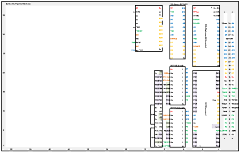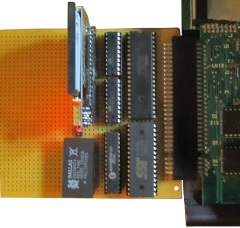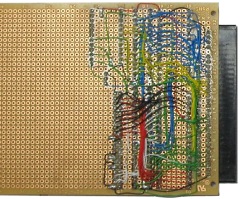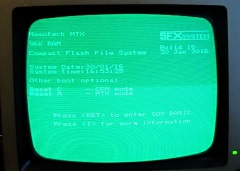|
 |
The Memotech MTX Series |
 |
Memotech Sdram compact Flash
eXpansion
SFX (PLACEHOLDER copied from CFX
page)
Introduction
SFX was
intended to be a
development of CFX, which itself
was spin-off of the Compact Flash storage system developed for
MTXPlus+, our modern day,
fully compatible, MTX "super computer". For full details of the
development and features of CFX, see the
CFX project page.
The idea for SFX came about
when someone asked about adding a software menu to make
navigating the few hundred files in the Compact Flash primary
partition (the B: drive) a little easier. Although we did not
actually do anything with that idea, I wondered whether we
could enhance CFX by squeezing MAGROM, perhaps with a reduced
number of games, into the CFX Flash to make loading many games
even easier than just adding a software menu.
Martin's initial reaction was that there
were no obvious technical barriers to doing it and he set about
looking at the details. Martin also suggested that we could add
32kb of RAM in a narrow DIP package to allow MTX500 owners to
increase the RAM to 64kb and thus be able to run CP/M.
. . . leading to the SFX name - for
SDRAM, Flash eXpansion
As the idea developed, MAGROM became an
early casualty, we thought that the board space would be better utilised by the addition
of the Real Time Clock from the MTXPlus+ design. The RTC we use
in MTXPlus+
is a pretty bulky package, it has a 28 pin DIP-600 footprint,
but is about half an inch high to accommodate the built in battery.
The Compact Flash interface in MTXPlus+
and CFX uses two of the 8-bit ports of an 82C55 PPI to
facilitate 16 bit access to the IDE interface. As well as
supporting Compact Flash cards, this interface would
theoretically also allow hard drives or optical drives to be
used, however, the use of those types of devices is unlikely to
have any practical use on a 4MHz MTX.
It is possible to use the Compact Flash
in 8 bit mode which does not require the 82C55, Martin did some
testing in 8-bit mode and found that the data transfer rate was
about twice as fast as 16 bit mode. We decided to use 8-bit mode
for SFX which would have been faster than CFX and reduce the component
footprint, at the expense of 16 bit compatibility.
While SFX was still at the concept stage,
a couple of other enhancements were added. Martin and I had been
discussing the Silicon Disk that was present in one of my FDXs
and decided that adding a Silicon Disk to SFX was feasible, In
addition, during
Memofest 2016, Bill Brendling had demonstrated an
80 Column card add on for CFX
based on the
Parallax Propeller. With the increased board space needed to
cater for the Silicon Disk and 80 column card components, the
RTC option was dropped.
As the design progressed, it became clear
that we were really working on an enhanced CFX, rather than a
completely new idea, so the SFX name was dropped and we decided
to rebadge the new design as CFX-II.
The notes below describe some of the
early work on SFX, this page is now
obsolete, see the CFX-II page for
details about the development of CFX-II.
Hardware
SFX will likely include :
-
An 82C55, CMOS Peripheral Interface Adapter
(PIA) (deleted)
-
An SSTSF010 128 kB x 8 CMOS Flash
-
A 32kb RAM in a narrow DIP package
-
A Programmable Logic Device (PLD or
CPLD) for glue logic
-
And few 74HCT chips performing simple
logic functions (NOT, AND, NAND, NOR).
|
Hardware |
Version 0.3 of the
prospective SFX design, incorporating a 32kB RAM, RTC,
82C55, 2 x GALs for I/O and Memory decode logic and
512kB Flash memory.
The Flash was to hold the
SFX System, CP/M and SDX ROMs, with the remaining
480kB initially intended to be used to store MAGROM game
files. |
 |
| Martin's V0.3 prototype
board |
 |
| Solder side of the V0.3
prototype board |
 |
The prototype board running
a version of the SFX ROM
The screen shows the
RTC working and the system seeing the additional 32K
of RAM - in this case, the board in plugged into a
64K MTX, giving 96K total RAM.
This was as
far as the proposed SFX got before Bill showed off
his 80 Column card board at
Memofest 2016. |
 |
For continued development
info - see CFX-II
References:
1 Andy Key's Memotech Hardware page
2 Que Publishing, Upgrading and
Repairing PCs, 21st Edition, ISBN-13: 978-0-7897-5000-6.
Sample Chapter : The ATA/IDE Interface
|